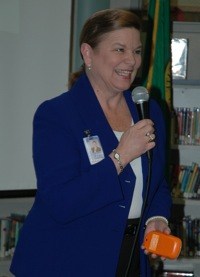ARLINGTON — Dr. Kristine McDuffy incorporated an interactive experiment for receiving feedback during her third annual “State of the District” address as Arlington School District superintendent.
As she spoke to parents, school staff and community members in the library of Kent Prairie Elementary on Jan. 25, McDuffy solicited her audience’s opinions anonymously through handheld electronic answering devices that students in seven of Kent Prairie’s classrooms use to answer math problems and test questions in real time.
Of those in attendance, 52 percent had lived in the district for six to 15 years, and 54.9 percent neither had any children in its schools, nor were they currently students themselves.
“We’re going to focus on the three ‘R’s of education tonight, although they’re different than the ones you remember,” McDuffy said. “They’re resiliency, resolve and results.”
McDuffy defined resiliency as the ability to adapt to change, and quoted the proverbial claim that the only constant is change. She asserted that this is especially true in a dynamic such as a school system, in which the students not only grow and evolve, but the national and state standards also represent a moving target.
When asked to identify the nation’s greatest challenge, 56 percent of the audience voted for fiscal stabilization, over the other options of global competitiveness, education and health care. When asked to identify the school district’s greatest challenge within the next five years, equal portions of the audience voted for the budget and getting all students to standard, with each one receiving 44.2 percent of the vote.
McDuffy agreed that the budget is one of the district’s three biggest challenges, along with striving to meet the continually changing national and state requirements for schools, as well as maintaining the focus on student achievement. Although the district’s students on free and reduced-price lunches increased from 17.1 percent in the 2007-08 school year to 27.4 percent in the 2009-10 school year, McDuffy offered some good news as well. She noted that the district’s current enrollment of 5,145 students exceeds its budgeted enrollment of 5,100 students, and added that district’s fund balance has gone from 0.3 percent in 2007-08 to 4.8 percent in 2009-10 and 2010-11.
“We don’t expect to do any reductions-in-force midyear,” said McDuffy, who nonetheless identified a $600,000 midyear shortfall for the Arlington School District. She likewise predicted that the elimination of federal “stimulus” funds and state-level budget cuts would reduce the district’s budget by $1.8 million in 2011-12, which is actually less than the $1.6 million by which the district originally reduced its budget for 2010-11.
McDuffy resolved to maintain not only the focus on student achievement, but also a safe and caring environment for students and a program of continuous self-improvement for the district as a whole. To that end, she explained that the district is working to align its strategic and district improvement plans with its school and department plans, to maximize the results of their efforts while also affording educators the flexibility to customize these plans to meet the needs of individual students.
McDuffy reported that the King County Superior Court found in favor of the Network for Excellence in Washington Schools last year, when NEWS sued the state for allegedly not meeting its own Constitutional requirement to provide ample provisions for all students. She also assured attendees who were worried about student achievement that the district’s goal is for every student to exceed standards, rather than just meeting them. She conceded the difficulties of realizing this goal, given the year-to-year changes in No Child Left Behind nationally, as well as the switch from the Washington Assessment of Student Learning to the Measurement of Student Progress and the High School Proficiency Exam on the state level, but still expressed optimism for the future.
“Our kids deserve our very best, even with all the other challenges that we face,” McDuffy said. “We’re going to get through this. Our community’s spirit is second to none.”
For more information on the state of the Arlington School District, log onto its website.







